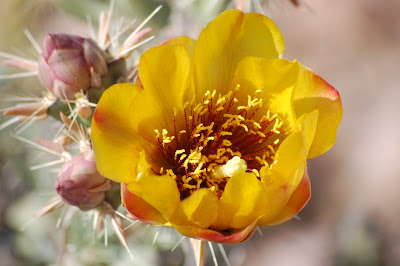We must have hit it at just the right time.
The Jeep bounced along a dirt road into the Superstition Wilderness which, these days, is merely a playground for Phoenix area residents. . . with wilderness rules.
We were looking for cactus flowers but never guessed we'd come across green ones. I've wandered this part of the desert for years but have never had the opportunity to see the Teddy Bear Cholla in bloom.
Maybe I just wasn't looking . . .or had unconsciously restricted my visual thinking to the more common yellows, orange, magenta, or other colors that decorate these plants. But...green? I knew they were out there, but just never "saw" them.
Cylindropuntia bigelovii is a cactus native to California, Arizona, New Mexico and northwestern Mexico. Enlarged stems carry out photosynthesis and store water. Unlike other succulents, the stem is the only part where this process takes place.
Flowers of some cacti form long tubes (up to 30 cm) so only certain species of moths can pollinate the blossoms. There are also specializations of this cholla for specific species of bats, hummingbirds and bees. To confuse us, the duration of flowering is highly variable...and probably the reason I've missed the event in past years.
Summer was a month away but the intensity of the southern Arizona sun got to us after several days. Your instinct is to cover up with a broad-brimmed hat, long sleeves and long pants. We did exactly that but beat a quick retreat to a local motel when it became uncomfortable.
Seed formation of these cacti is prolific and the fruits are conspicuous. A menagerie of goats, moths, birds, ants, mice and bats eat the fruit contributing to seed dispersal and cactus reproduction.
Some cacti have a waxy coating on their stems to prevent water loss. Because of the plants' water-retention ability, detached sections of the plant can survive for long periods and grow new roots when rain comes.
These Teddy Bears are resourceful, leaving no aspect of their reproduction to chance.
Bees, spiders and other bugs take care of pollination. Moths, birds, mice and bats eat the fruit and disperse seeds. Their last method of "reproduction" is more insidious...stem sections detach when brushed by passing humans, dogs, foxes, javelina or other desert inhabitants.
Perhaps the next time you pass too closely and say, "OUCH!" and use a comb or tweezer to remove a stem section, smile and remember you're part of a group effort to help cylindropuntia bigelovii give birth.
Labels: cactus flower, cactus flower photography, cylindropuntia bigelovii, desert environment, Mel Burke, superstition wilderness, teddy bear cholla








